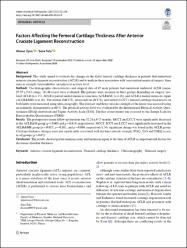| dc.contributor.author | Üşen, Ahmet | |
| dc.contributor.author | Tolu, Sena | |
| dc.date.accessioned | 2021-10-12T09:29:33Z | |
| dc.date.available | 2021-10-12T09:29:33Z | |
| dc.date.issued | 2021 | en_US |
| dc.identifier.citation | Üşen, A. ve Tolu, S. (2021). Factors affecting the femoral cartilage thickness after anterior cruciate ligament reconstruction. Indian Journal of Orthopaedics, 55(2), 352-359. https://dx.doi.org/10.1007/s43465-020-00262-9 | en_US |
| dc.identifier.issn | 0019-5413 | |
| dc.identifier.issn | 1998-3727 | |
| dc.identifier.uri | https://dx.doi.org/10.1007/s43465-020-00262-9 | |
| dc.identifier.uri | https://hdl.handle.net/20.500.12511/8433 | |
| dc.description.abstract | Background This study aimed to evaluate the changes in the distal femoral cartilage thickness in patients that underwent anterior cruciate ligament reconstruction (ACLR) and to analyze their association with concomitant meniscal surgery, knee muscle strength, kinesophobia, and physical activity level. Methods The demographic characteristics and surgical data of 47 male patients that underwent unilateral ACLR (mean, 27.55 +/- 5.63; range, 18-40 years) were evaluated. The patients were assessed in three groups depending on surgery: isolated ACLR (n = 15), ACLR + partial medial meniscus resection (ACLR&M) (n = 16), and ACLR + medial meniscus repair (ACLR&MR) (n = 16). The medial (MCCT), intercondylar (ICCT), and lateral (LCCT) femoral cartilage thicknesses on both limbs were measured using ultrasonography. The extensor and flexor muscles strength of the knees was assessed using an isokinetic dynamometer at 60 degrees/s. The physical activity level was evaluated by the International Physical Activity Questionnaire (IPAQ) short form and Tegner Activity Scale (TAS). The fear of movement was assessed by the Tampa Scale for Kinesiophobia Questionnaire (TSKQ). Results The postoperative mean follow-up duration was 32.24 +/- 9.17 months. MCCT and LCCT were significantly decreased in the ACLR&M group (p < 0.001 andp = 0.019, respectively). MCCT, ICCT and LCCT were significantly decreased in the ACLR&MR group (p = 0.017,p = 0.011, andp = 0.004, respectively). No significant change was found in the ACLR group. Cartilage thickness changes were not significantly correlated with the knee muscle strength, IPAQ, TAS and TSKQ scores in all groups (p > 0.05). Conclusion The results showed partial meniscectomy and meniscus repair at the time of ACLR as important risk factors for decreased chondral thickness. | en_US |
| dc.language.iso | eng | en_US |
| dc.publisher | Springer Heidelberg | en_US |
| dc.rights | info:eu-repo/semantics/openAccess | en_US |
| dc.subject | Anterior Cruciate Ligament Reconstruction | en_US |
| dc.subject | Femoral Cartilage Thickness | en_US |
| dc.subject | Ultrasonography | en_US |
| dc.subject | Meniscal Surgery | en_US |
| dc.title | Factors affecting the femoral cartilage thickness after anterior cruciate ligament reconstruction | en_US |
| dc.type | article | en_US |
| dc.relation.ispartof | Indian Journal of Orthopaedics | en_US |
| dc.department | İstanbul Medipol Üniversitesi, Tıp Fakültesi, Dahili Tıp Bilimleri Bölümü, Fizik Tedavi ve Rehabilitasyon Ana Bilim Dalı | en_US |
| dc.authorid | 0000-0002-2754-1232 | en_US |
| dc.authorid | 0000-0002-1111-3110 | en_US |
| dc.identifier.volume | 55 | en_US |
| dc.identifier.issue | 2 | en_US |
| dc.identifier.startpage | 352 | en_US |
| dc.identifier.endpage | 359 | en_US |
| dc.relation.publicationcategory | Makale - Uluslararası Hakemli Dergi - Kurum Öğretim Elemanı | en_US |
| dc.identifier.doi | 10.1007/s43465-020-00262-9 | en_US |
| dc.identifier.wosquality | Q4 | en_US |
| dc.identifier.scopusquality | Q3 | en_US |


















